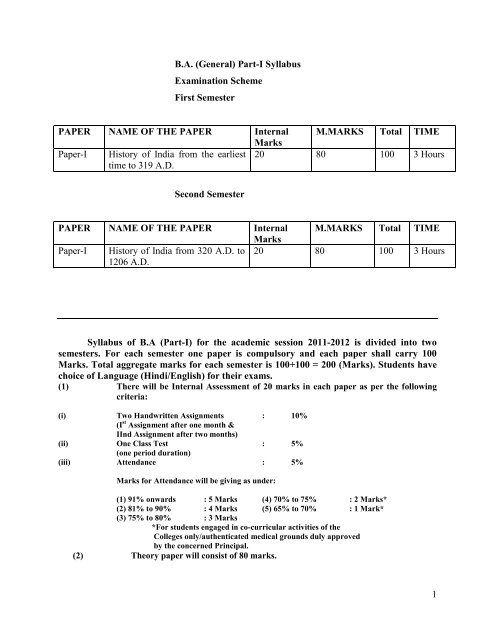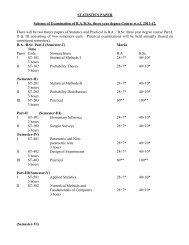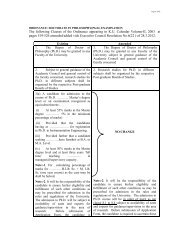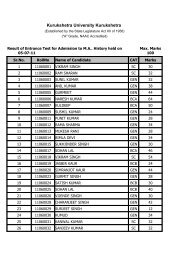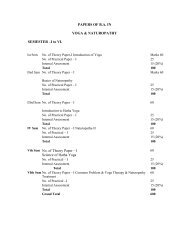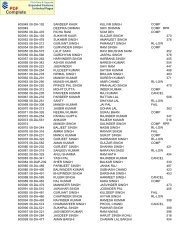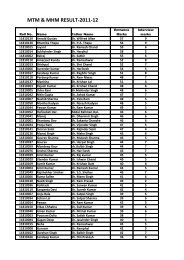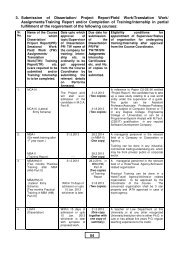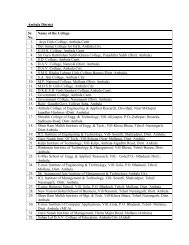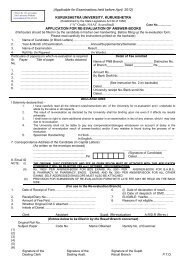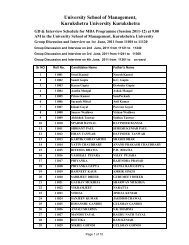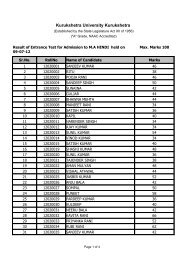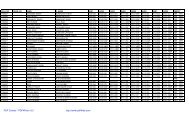1 B.A. (General) Part-I Syllabus Examination Scheme First Semester ...
1 B.A. (General) Part-I Syllabus Examination Scheme First Semester ...
1 B.A. (General) Part-I Syllabus Examination Scheme First Semester ...
- No tags were found...
You also want an ePaper? Increase the reach of your titles
YUMPU automatically turns print PDFs into web optimized ePapers that Google loves.
B.A. (<strong>General</strong>) <strong>Part</strong>-I <strong>Syllabus</strong><strong>Examination</strong> <strong>Scheme</strong><strong>First</strong> <strong>Semester</strong>PAPER NAME OF THE PAPER Internal M.MARKS Total TIMEMarksPaper-I History of India from the earliesttime to 319 A.D.20 80 100 3 HoursSecond <strong>Semester</strong>PAPER NAME OF THE PAPER Internal M.MARKS Total TIMEMarksPaper-I History of India from 320 A.D. to1206 A.D.20 80 100 3 Hours<strong>Syllabus</strong> of B.A (<strong>Part</strong>-I) for the academic session 2011-2012 is divided into twosemesters. For each semester one paper is compulsory and each paper shall carry 100Marks. Total aggregate marks for each semester is 100+100 = 200 (Marks). Students havechoice of Language (Hindi/English) for their exams.(1) There will be Internal Assessment of 20 marks in each paper as per the followingcriteria:(i) Two Handwritten Assignments : 10%(I st Assignment after one month &IInd Assignment after two months)(ii) One Class Test : 5%(one period duration)(iii) Attendance : 5%Marks for Attendance will be giving as under:(1) 91% onwards : 5 Marks (4) 70% to 75% : 2 Marks*(2) 81% to 90% : 4 Marks (5) 65% to 70% : 1 Mark*(3) 75% to 80% : 3 Marks*For students engaged in co-curricular activities of theColleges only/authenticated medical grounds duly approvedby the concerned Principal.(2) Theory paper will consist of 80 marks.1
FIRST SEMESTERANCIENT INDIAN HISOTRY, CULTURE AND ARCHAEOLOGYPaper: History of India(From the earliest time to 319 A. D.)Max. Marks: 80Internal Assessment: 20Time: 3 HoursNote:- 1.At least 10 questions will be set in five sections. TheCandidates will have to attempt 5 questions in all, selecting at leastone question form each section.1. There shall be a compulsory question on the map carrying 18 marks (12 formap work and 6 for explanatory note).Blind candidates may not attempt themap question. In lieu of the map question, they may attempt any otherquestion. However, in case, they wish to attempt the map question, the partrelating to the explanatory note will carry full marks.2. There shall be 1 objective type question. The question will be divided intothere Sections. Section-1 shall have snap shot type questions of 8 marks.Section-II will have multiple choice questions of 5 marks. Section-III willhave matching type questions of 5 marks.Section-ISources of Indian History, Paleolithic, Mesolithic and Neolithic Cultures ofIndia.Section-IISalient features of the Indus Valley Civilization. Original Home of the earlyVedic people. Political and Administrative conditions of Vedic age.Section-IIIThe age of the Mahajanapadas: Rise and growth of Magadhan empire (fromBimbisar to the Nanads) Buddhism and Jainism, the invasion of Alexander and itseffects, the Mauryas: Chandragupta and Ashoka Satavahanas, Sakas & Kushanas.Section-IVMaps:1. Important Sites of the Harappan Culture.2. India during the Sixth Century B.C.3. Extent of Ashoka Empire, Pillar and Edicts.4. Kanishka’s Empire.Section-VObjective Type Question (covering entire syllabus, Section I-III)2
Books Recommended:1. Majumdar, Ray : An Advanced History of India.Chaudhary & Datta :2. Tripath, R.S. : Ancient India.3. Basham, A : The Wonder That was India, London 19544. Ray Chaudhary, H.C. : Political Hisotry of Ancient India,Calcutta, 1963.5. Sastri. K.A.N : The age of the Nandas and Mauryans(In English and Hindi)6. Jai Narain Pandey : Puratattva Vimarash, 20097. Majumder, R.C. and : Vedic Age.Pusalkar, A.D.8. Wheeler R.E.M. : The Indus Civilization.9. Thaplyal, K.K and ; Sindhu Sabhyata (In Hindi).Shukla, S.P.3
SECOND SEMESTERANCIENT INDIAN HISOTRY, CULTURE ANDARCHAEOLOGYPaper: History of India(From 320 A. D. to 1206 A. D.)Max. Marks: 80Internal Assessment: 20Time: 3 HoursNote:- 1.At least 10 questions will be set in five sections. The Candidates will have toattempt 5 questions in all, selecting at least one question form each section.1. There shall be a compulsory question on the map carrying 18 marks (12for map work and 6 for explanatory note).Blind candidates may notattempt the map question. In lieu of the map question, they may attemptany other question. However, in case, they wish to attempt the mapquestion, the part relating to the explanatory note will carry full marks.2. There shall be one objective type question. The question will be dividedinto three Sections. Section-1 shall have snap shot type questions of 8marks. Section-II will have multiple choice questions of 5 marks. Section-III will have matching type questions of 5 marks.Section-IThe Gupta Empire: achievements of Smudragupta, Chandragupta-IISkandagupta. Downfall of Gupta Empire.Section-IIRise and fall of Pushyabhutis, Chalukyas of Badami. Pratiharas, the Palas and theRastrakutas, the Chahamana as the Gahadavals and the Parmaras. Dynasties of theSouth-the Pallavas and the Cholas.Section-IIIThe Arab and the Turk invasions- Muhammad-bin-Kasim, Mahmud Ghaznaviand Muhammad Ghori.Section-IVMaps:1. Samudragupta Empire.2. Samudragupta’s Conquests.3. Extent of Harsha Empire.4. Chola Empire.4
Section-VObjective Type Question (covering entire syllabus, Section I-III)Books Recommended:1. Yazdani : Early History of Deccan, Oxford,19602. Shastri, N.K. : Ancient India.3. Panday, R.B. : The Wonder That was India,London4. Majumdar, R.C. : Ancient India, Delhi,19775. Ghosh, N.N : Early History of India, Allahabad.6. Jha, D.N. : Prachin Bharat (Delhi,1980)7. Majumdar & Altekar : The Vakatka Gupta Age,Delhi, 1953.8. Tripati, R.S. : History of Kanauj.9. Puri B.N. : History of the Gurjara Pratiharas.5
B.A. (<strong>General</strong>) <strong>Part</strong>-II <strong>Syllabus</strong><strong>Examination</strong> <strong>Scheme</strong>THIRD SEMESTERPAPER NAME OF THE PAPER Internal M.MARKS Total TIMEMarksPaper-I Social History of India(From the earliest time to 1200 A. D.)20 80 100 3 HoursFORTH SEMESTERPAPER NAME OF THE PAPER Internal M.MARKS Total TIMEMarksPaper-I Economic History of India(From the earliest time to 1200 A. D.)20 80 100 3 Hours<strong>Syllabus</strong> of B.A (<strong>Part</strong>-II) for the academic session 2011-2012 is divided into twosemesters. For each semester one paper is compulsory and each paper shall carry 100Marks. Total aggregate marks for each semester is 100+100 = 200 (Marks). Students havechoice of Language (Hindi/English) for their exams.(1) There will be Internal Assessment of 20 marks in each paper as per the followingcriteria:(i) Two Handwritten Assignments : 10%(I st Assignment after one month &IInd Assignment after two months)(ii) One Class Test : 5%(one period duration)(iii) Attendance : 5%Marks for Attendance will be giving as under:(1) 91% onwards : 5 Marks (4) 70% to 75% : 2 Marks*(2) 81% to 90% : 4 Marks (5) 65% to 70% : 1 Mark*(3) 75% to 80% : 3 Marks*For students engaged in co-curricular activities of theColleges only/authenticated medical grounds duly approvedby the concerned Principal.(3) Theory paper will consist of 80 marks.6
THIRD SEMESTERANCIENT INDIAN HISOTRY, CULTURE ANDARCHAEOLOGYPaper-I: Social History of India(From the earliest time to 1200 A. D.)Max. Marks: 80Internal Assessment: 20Time: 3 HoursNote:- 1. At least 10 questions will be set in four sections. TheCandidates will have to attempt 5 questions in all, selecting at leastOne question from each section.2. There shall be one objective type question. The question will bedivided into three Sections. Section-1 shall have snap shot typequestions of 8 marks. Section-II will have multiple choice questions of5 marks. Section-III will have matching type questions of 5 marks.Section-ISocial life of Indus Valley Civilization and Vedic period.Section-IIOrigin and Development of Varna, Jati and Samskara.Section-IIIPosition of Women (Property right, Education, Sati and Devadasi system)Marriage: Slavery and Untouchability.Section-IVObjective Type Question (Covering entire syllabus, section- III)7
FORTH SEMESTERANCIENT INDIAN HISOTRY, CULTURE ANDARCHAEOLOGYPaper-I: Economic History of India(From the earliest time to 1200 A. D.)Max. Marks: 80Internal Assessment: 20Time: 3 HoursNote:- 1.At least 10 questions will be set in four sections. TheCandidates will have to attempt 5 questions in all, selecting at leastone question from each section.2. There shall be one objective type question. The question will be divided intothree Sections. Section-1 shall have snap shot type questions of 8 marks.Section-II will have multiple choice questions of 5 marks. Section-III willhave matching type questions of 5 marks.Section-IEconomic life during Harppan Civilization and Vedic period, <strong>First</strong> and secondUrbanization.Section-IIEconomic conditions during Mauryas & Guptas.Section-IIITrade and commerce in Ancient India, Origin and Growth of Feudalism.Section-IVObjective type question (Covering entire syllabus, section -III)9


